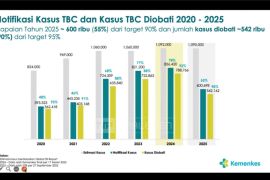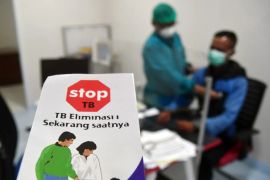"Our country is the second-largest contributor to tuberculosis cases in the world, and the first is India. However, India's population is 1.3 billion, much higher than Indonesia," Aditama noted in a statement here on Tuesday.
He then cited the India TB Report 2024 published in April 2024 that showed a decrease in the tuberculosis death rate in the country, from 28 per 100 thousand population in 2015 to 23 per 100 thousand population in 2022.
Other data also showed that deaths from tuberculosis in India fell, from 494 thousand in 2021 to 331 thousand in 2022.
"One of the most important achievements in controlling tuberculosis in India is that the country has succeeded in reducing the mortality rate due to tuberculosis," he remarked.
Aditama, who is concurrently the former Director of Infectious Diseases at WHO Southeast Asia, highlighted that another accomplishment of India's tuberculosis program was that the country had succeeded in achieving the target of treating 95 percent of its sufferers by 2023. This percentage was high.
In implementing the program, most cases in India are handled by public health service facilities. However, the role of the private sector also continues to increase.
Some 33 percent of the cases, or around 840 thousand cases, were handled by the private sector in 2023.
"This figure has increased significantly, from the 190 thousand cases handled by the private sector in 2015," he remarked.
Aditama also noted that the Indian government had also drawn attention to five challenging risk factors in controlling tuberculosis, namely malnutrition, HIV, diabetes, alcohol, and smoking.
Regarding the risk factors for malnutrition, the local government provides cash assistance for tuberculosis patients who are malnourished, and this is done on a monthly basis.
"Of course, this also needs to be taken into consideration. There is also a food basket program," he remarked.
He stated that HIV can increase the risk of tuberculosis by up to 20 folds. Meanwhile, diabetes increases the risk of tuberculosis by two to three folds, and this is also associated with a possible risk of multi-drug resistant tuberculosis (MDR TB).
"It would be better if the experience from India was also taken into consideration and studied by the government in order to make appropriate policies for handling tuberculosis in our country," he emphasized.
In the meantime, the Ministry of Health reported that the estimated number of tuberculosis cases in Indonesia as of March 1, 2024, had reached 1,060,000, with 821,200 cases notified.
Of the notified figure, 77 percent of them underwent a treatment program, with 12,482 of them being notified as having drug-resistant tuberculosis (RO).
Meanwhile, a total of 136,969 cases of tuberculosis were found in children, 16,731 cases of HIV tuberculosis, and 23,858 people had died from the disease.
Related news: Companies must protect employees with TB from stigma: ministry
Related news: Jakarta expedites TB control efforts with TB alert villages
Related news: Indonesia's drug-sensitive TB cases recorded at 808,000 in 2023: govt
Translator: Andi Firdaus, Katriana
Editor: Azis Kurmala
Copyright © ANTARA 2024











